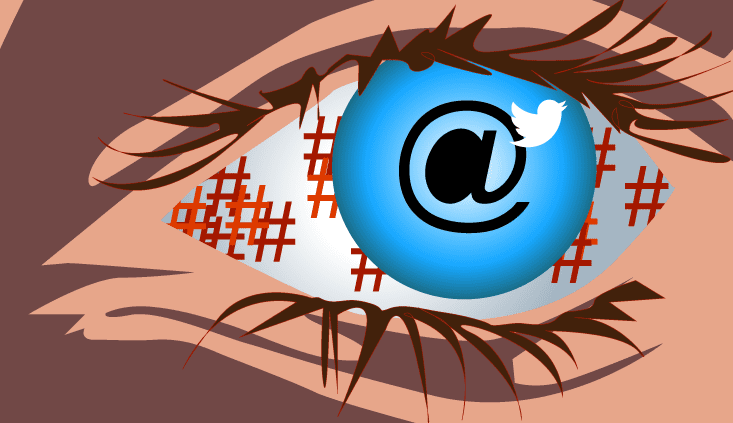In the fall of 2014, when health officials were fighting to contain an Ebola outbreak in West Africa, Emilio Ferrara was tracking another, far more pervasive pandemic. The contagion entered the body through the eye, hijacking cells in the retina to gain access to the brain. There, it burrowed through webs of neurons to the deepest, most ancient brain regions, beyond the realm of consciousness, where it wreaked its havoc on the autonomic nervous system, which controls bodily functions such as respiration, heart rate, and digestion.
The infection was spreading fast, jumping from one person to thousands across the globe in mere minutes. Victims felt its effects before they could recognize them: sweaty palms, shortness of breath, a rapid heartbeat and blood sugar rush, muscle contractions that felt like a punch to the gut. Scientists refer to this constellation of symptoms as the stress response. We might call it fear.

In the early days of the Ebola scare, Ferrara, now a computer scientist at the University of Southern California, had written a program to mine Twitter for conversations about the disease and analyze their emotional sentiment. He knew that emotions pass easily from person to person, even through social media—a phenomenon known as emotional contagion. But panic about the virus was diffusing quicker than he’d expected.
Then, on September 30, he noticed an unprecedented surge of data flowing into his system. He signed onto Twitter to try to identify the culprit. And there it was:
@CNN: #BREAKING: 1st diagnosed case of #Ebola in the U.S. confirmed.
Ebola had arrived in the United States. The patient, 42-year-old Thomas Eric Duncan, had traveled to Dallas, Texas from Liberia 10 days prior. As the deadly virus coursed through Duncan’s blood, Ferrara watched fear course through the Internet.
Within days, hysteria set in.
@FoxNews: Dr. Gil Mobley on #Ebola: “These clusters are coming … and we are woefully unprepared.”
@AlexVanscoy_: we’re dead, Ebola is going to kill us all.
By the following month, according to a Gallup poll, Ebola ranked third among Americans’ top healthcare concerns, after costs and access. Although the U.S. Centers for Disease Control and Prevention had confirmed only four cases, more than 1 in 6 Americans believed Ebola was the nation’s biggest health problem.
Fear mongering works not because we’re especially gullible, but because stress is especially contagious.
How could this misperception have propagated so rapidly? In the Twitter data, Ferrara saw a plausible explanation: “Fear-rich” tweets, he discovered, triggered re-tweets twice as fast, on average, than neutral posts or posts conveying other emotions such as happiness. “Fear was spreading wider and faster than other types of information,” he says.
His findings (yet to be published) confirmed what many social psychologists have long suspected: Fear-induced stress is at the root of mass hysteria. When we hear or read about a threat—that vaccines cause autism, that immigration begets terrorism, or that an explosion at the White House injured Obama—our bodies respond to it as if it were real before our conscious minds can evaluate its truth. And because we feel threatened, we’re more likely to believe that we are, and to share our fears with others.
Fear mongering works, in other words, not because we’re especially gullible or misinformed, but because stress is especially contagious.

The word empathy comes from the German einfühlung, meaning “feeling into.” Philosophers in the 18th and 19th centuries used the term to describe our ability to take aesthetic pleasure in inanimate things. It wasn’t until the early 1900s that we began to speak of empathy as a social force. Writing in 1905, the German professor Theodor Lipps defined empathy as the “inner imitation” of the “experience of another human.” Just as it allows us to recognize human qualities in a sunset or painting, Lipps argued, empathy allows us to recognize each other as minded beings.
A century later, neuroscientists found biological evidence for this “inner imitation” in the form of mirror neurons, which fire both when an animal performs a task and when it sees another animal performing the same task. Similarly, brain-imaging studies in humans show that when we witness someone expressing an emotion—such as sorrow or disgust—the experience activates some of the same brain regions as when we feel that emotion ourselves. It’s this “mirror system,” researchers suspect, that enables us to understand the actions and sensations of others by recreating their mental state, or some version of it, in our own neural code.
“What this means is that in human interaction there is a bidirectional flow of information,” says Marco Iacoboni, a professor of psychiatry and biobehavioral sciences at the University of California, Los Angeles. “The way we empathize with others, the way we catch the feelings of other people—and that includes stress—is that through mirroring, our body reacts to others.”
The most-emailed Times stories tended to evoke “high-arousal” emotions such as awe, anger, and anxiety.
The concept of “stress contagion,” or “empathetic stress,” dates back to the 1980s, when scientists studying social networks found that simply being exposed to others’ problems can make people feel more distressed. In investigating the impact of the 1982 Israel-Lebanon War, for example, researchers were surprised to learn that survivors who had more social support were also the most troubled. When pressed, participants admitted that most of their social interactions involved swapping rumors about the war, almost all of which were upsetting. Commiseration, it seemed, only fanned misery.
But stress isn’t just psychological—it’s is also physiological. When we’re stressed, our bodies circulate hormones that trigger a cascade of reactions known as the stress response: Our heart rate and blood sugar rise; our senses sharpen; our immune defenses mobilize; and unessential processes like digestion and growth slow down. Scientists began to wonder: If stress is truly communicable, shouldn’t we catch these physical symptoms too?
Research led by Veronika Engert, a social neuroscientist at the Max Planck Institutes, in Germany, suggests this is indeed the case. In a 2014 study, she and her colleagues recruited more than 150 pairs of strangers and romantic couples. While one person underwent a stressful test—involving a fictitious job interview and grilling by “behavioral analysts”—the other person watched via a one-way mirror or video feed. As expected, nearly all of the test-takers showed signs of stress, as measured by an increase of the stress hormone cortisol in their saliva. Remarkably, however, 1 in 4 observers also experienced a cortisol spike just by seeing their partner put under pressure.
The neural processes behind this reflex may explain why stress is so infectious compared to other emotions. More self-aware feelings, like joy and sadness, arise largely from activity in the brain’s outer layers, or neocortex, the domain of reason and conscious thought. The stress response, however, starts near the brain’s core, in the almond-shaped amygdala. This evolutionarily ancient structure is responsible for impulsive behaviors: During an emergency, the amygdala commandeers brain circuits that spring you into action, essentially hijacking control from the rational mind. The operation is so quick that your body will react to a perceived threat—or someone else’s perceived threat—before you’re fully aware of what’s happening.
In 2001 and 2002, the luxury automaker BMW created a series of short web films called The Hire, which featured its cars in harrowing scenes: speed chases, shootouts, kidnappings, heists. As a marketing tactic, the films defied a common tenet of advertising, which says that products should be presented in a positive light. But the campaign proved a huge success: Within four months, The Hire had been viewed more than 11 million times, and BMW sales rose by 12.5 percent.

According to Jonah Berger and Katherine Milkman, researchers at the University of Pennsylvania’s Wharton School of Business, BMW didn’t just get lucky. Rather, the company hit on a recipe for virality. In a 2012 study, Berger and Milkman analyzed 7,000 The New York Times articles to try to determine why readers shared some articles more than others. They found that, like the BMW films, the most-emailed Times stories tended to evoke “high-arousal” emotions such as awe, anger, and anxiety. “While one might be concerned that negative emotion would hurt the brand, our results suggest that it should increase transmission because anxiety induces arousal,” they write.
If a negative emotion is caught and conveyed above a certain threshold, it’s capable of being sent across the world.
From an evolutionary perspective, stress contagion makes a lot of sense. As social creatures, our ancestors may have gained a survival advantage by learning to recognize when others feel threatened and quickly react. Responding impulsively to another person’s stress prepares our bodies to fight or flee while our conscious minds try to work out the cause of the distress and decide what to do about it. By the time we identify a stalking lion, for instance, our legs are ready to run.
On the Internet, however, fear and anxiety can spread faster and further than ever before. People who use social media tend to be more aware of stressful events in others’ lives, according to the Pew Research Center. And the more aware they are, the more stressed they feel. “Let’s say you read your news stream, and all of these people are posting about a shooting,” Ferrara explains. “Even though you may not interact with it directly, in a latent form, that information can affect your internal wellbeing—it can cause a negative emotion and reaction.”
It can also make you more likely to share that negativity with others. In a controversial study published in 2014, engineers at Facebook and Cornell University manipulated the News Feeds of more than 600,000 users. People who saw fewer negative posts shared more positive content, while people who saw fewer positive posts shared more negative content. Another study tracked the effects of weather on collective gloom: On rainy days, Facebook users posted more negative updates—as did their friends in dryer locales. “We estimate that a rainy day in New York City directly yields an additional 1,500 negative posts by users in New York City and about 700 negative posts by their friends elsewhere,” the researchers write.
“Emotion is a language,” says Greg Norman, a professor of psychology at the University of Chicago. “It’s not nearly as explicit as English—it’s far more subtle—but it has a considerable effect: If a negative emotion is caught and conveyed above a certain threshold, it’s capable of being sent across the world.”
Ferrara worries about the consequences of such widespread contagion. Beyond the Ebola scare, he says, the snowballing of fear online likely explains why smear campaigns dominate politics, why Twitter rumors can crash the stock market, and why ISIS’s beheading videos have become successful propaganda. He points to studies suggesting that stress spread by trolling and cyber-bullying may raise instances of suicide and depression.
So is there an antidote to this epidemic? Maybe. Ferrara is currently designing algorithms, based the Ebola tweets and similar data, to help public officials communicate emergency information in ways least likely to set off a fear cascade. Language, he says, is important, but so is the timing and detail of the message. He also advocates for developing technologies to detect online harassment and putting policies in place to discourage abuse.
Stress is so pervasive, though, it’s unlikely we can ever really escape it. As social creatures, our anxieties are never just ours alone. And there will always be people—politicians, trolls, even our own friends—who rile us up about bogus, or exaggerated, threats. When the next global crisis looms, the one pandemic we can count on is fear.

Adrienne Berard teaches journalism at Delta State University and previously wrote about suburbia and gemstones for Nautilus. She lives in Cleveland, Mississippi.



